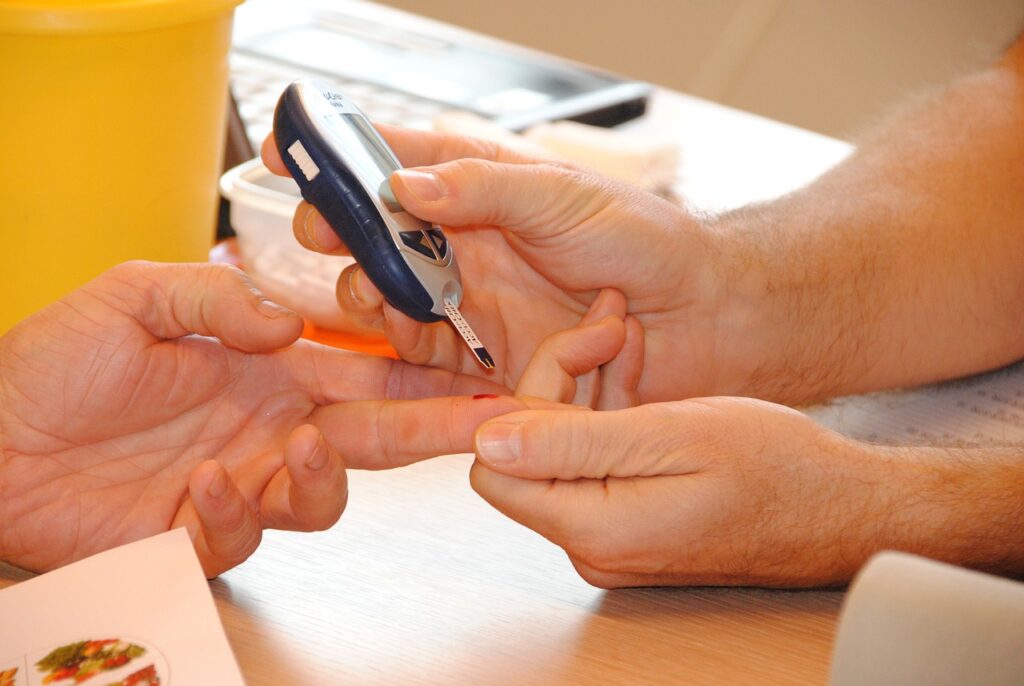
Blood sugar management is a key part of prediabetes monitoring and requires constant vigilance. In everyday life, several factors influence blood glucose levels, such as medication, eating habits and physical activity. But how does sport help keep blood sugar low? Is sport really recommended for people with pre-diabetes? In this article, we will first look at the links between sport and blood sugar levels, and then we will see how to combat a sedentary lifestyle to prevent the development of type 2 diabetes.
Keeping diabetes under control thanks to sport
The relationship between exercise and blood sugar levels
Sport lowers blood sugar levels because it increases the sensitivity of tissues to the insulin secreted by the pancreas (https://www.diabetes.org/healthy-living/fitness/getting-started-safely/blood-glucose-and-exercise). This means that when exercising, the cells that make up the muscles become temporarily more receptive to this hormone. This intensifies the extraction of nutrients from digestion (including glucose) and lowers blood sugar levels.
Targeting abdominal fat to combat type 2 diabetes
Some sports disciplines, which are geared towards muscle strengthening, actively combat visceral fat. Visceral fat is located behind the abdominal muscles and is found around organs such as the intestine and the liver. The accumulation of this type of fat is dangerous to health, especially for pre-diabetics and diabetics. It promotes insulin resistance; i.e., the ability of cells (whether fat, liver or muscle) to take up glucose and then use it. According to the results of a Spanish study from 2005 (https://pubmed.ncbi.nlm.nih.gov/15735205/), a 16-week training session focusing on the sheathing of the upper body (arms and abdomen) can lead to:
- a decrease in visceral fat of more than 10% (compared to the volume of fat at the start),
- an increase in insulin sensitivity of more than 46%,
- and most importantly, a drop in fasting blood sugar levels of over 7%.
Even without a significant weight loss, practising targeted movements in order to build up the stomach muscles therefore appears to be a way of regulating the blood sugar levels of a pre-diabetic.
Lowering HbA1c by exercising
According to certain scientific publications (https://pubmed.ncbi.nlm.nih.gov/34509590/), regular practice of sport leads in the medium and long term to a reduction in insulin resistance, and therefore in the glycated haemoglobin level (or HbA1c). This percentage, which is obtained by blood test, is essential for monitoring diabetes because it reflects the average concentration of glucose in the blood over the last two or three months
Unlike fasting or capillary (i.e., transcutaneous) blood glucose monitoring, glycated haemoglobin measurement gives an overview of blood glucose control over a long period of time. This allows the future course of the disease to be anticipated, as well as the occurrence of possible serious complications such as neuropathy, retinopathy, nephropathy, stroke and myocardial infarction. Maintaining a balanced HbA1c level is a priority for every pre-diabetic and diabetic. Sport can help: by cross-referencing data from 27 field experiments (https://www.sciencedirect.com/science/article/abs/pii/S0531556521003314), researchers have shown that regular fitness and aerobic exercise (even with low or moderate effort) in 1,500 men and women aged 45 and over can reduce glycated haemoglobin levels by an average of 0.47%.
Hypoglycaemia and sport
Since sport lowers blood sugar levels, hypoglycaemia can occur in some cases. The blood sugar level then falls below 0.7 grams per litre and the following symptoms occur:
- trembling,
- sudden tiredness,
- paleness,
- abnormal sweating,
- palpitations,
- headaches,
- a feeling of dizziness,
- blurred vision,
- even convulsions (in the case of a severe attack).
If these symptoms occur during sport, a break with a sugar intake is absolutely necessary.
Before a diagnosis: how to prevent diabetes thanks to sport ?
Overweight and diabetes, a harmful combination
Obesity is the main risk factor for the development of high blood pressure, cardiovascular disease and type 2 diabetes. The sedentarity of some populations has led to a sharp increase in the number of people affected by these diseases over the past few decades, on all five continents. Indeed, according to recent projections by a team of researchers (https://www.karger.com/Article/Fulltext/480525), 60% of the world’s population could be obese by the beginning of the 2030s, and the number of overweight diabetics should reach 300 million by 2025. This is a major health issue, as the combination of obesity and diabetes is dangerous – especially when diagnosed late. In addition to prophylactic medication, diabetes can be prevented primarily through a healthy diet and lifestyle, combined with daily exercise.
A healthy lifestyle to keep blood sugar levels under control
Losing weight (even a little) is an excellent tool for preventing or controlling diabetes. Combined with a balanced diet and smoking cessation, sport reduces body fat, stimulates blood circulation and facilitates the proper regulation of carbohydrates in the blood by insulin. During a pre-diabetes phase, regular sport can even help to avoid a future diagnosis of diabetes.
A good way to relieve stress
While anxiety is never the sole cause of type 2 diabetes, it is entirely possible that it plays a role in triggering the condition (https://www.pep2dia.fr/le-blog-pep2dia/stress-sport-et-glycemie-avec-martine-duclos/). Indeed, high levels of cortisol and adrenaline (the stress hormones) could promote malfunctioning of the insulin-producing pancreatic cells (https://www.diabetes.org.uk/guide-to-diabetes/emotions/stress). British studies to be published from 2022 onwards (https://www.diabetes.org.uk/research/our-research-projects/midlands/can-stress-hormones-protect-beta-cells and https://www.diabetes.org.uk/research/our-research-projects/midlands/stress-hormones-and-risk-of-type-2-diabetes) should make it possible to confirm or refute this cause-and-effect relationship. One of the best tools for reducing anxiety in people at risk is sport, as it promotes the production of anti-stress hormones such as endorphins and dopamine.
A sporting activity for every pre-diabetic
Resuming physical exercise after a long period of inactivity can sometimes be difficult. However, there are light yet effective activities to help prevent diabetes, such as :
- yoga,
- cycling,
- Pilates,
- water aerobics,
- or Nordic walking
Exercising can be fun
Sport is not the only way to slim down and build up muscle mass. There are leisure activities that focus on movement, which are beneficial to health and can be practised alone, with the family, as a couple or with friends. This is the case for :
- bowling, which burns 273 calories per hour (https://www.businessinsider.com/relaxing-exercises-burn-most-calories-2017-4?IR=T),
- golf (391 calories per hour, when the player carries his clubs across the course),
- ballroom dancing (273 calories per hour of practice),
- or walking (255 calories per hour at a slow pace, or 391 calories for a brisk walk).
A more active everyday life
Many seemingly innocuous actions help to combat a sedentary lifestyle. Repeating them several times a day can improve the general physical condition of the pre-diabetic individual, reduce body fat and protect against type 2 diabetes. These beneficial habits include :
- taking the stairs (instead of the lift),
- shopping at the supermarket (instead of using a delivery service),
- vacuuming (instead of using an autonomous robot to clean the floor),
- alking to do groceries (instead of taking the car or public transport),
- doing DIY (instead of hiring craftsmen),
- and growing your own garden (instead of buying vegetables).
Exercise is a must for anyone with prediabetes or type 2 diabetes. More than a comfort measure, it is a powerful weapon in diabetes prevention, blood sugar management, insulin resistance and glycated haemoglobin control. Although training programmes that focus on muscle gain and calorie loss are the most relevant, all forms of exercise (even the less athletic and more playful ones) are useful in the fight against diabetes.
Our latest publications
Want to learn more about topics related to blood sugar management?
Here are our most recent blog posts!



